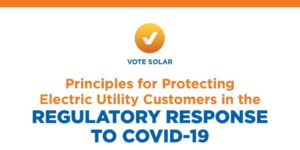Principles for Protecting Electric Utility Customers in the Regulatory Response to COVID-19
As COVID-19’s public health and economic crises change our communities, electric utilities across the country hold a unique responsibility to ‘keep the lights on,’ especially for their most vulnerable customers. Economically disrupted ratepayers are increasingly unable to pay their utility bills in a time when staying safe and secure at home remains a public health priority.
During the initial months of the crisis, states and utilities have generally responded by ensuring that customers can stay connected and instituting a moratorium on shutoffs. While shut off protection has kept the lights on for economically disrupted households across the country, these households are accumulating utility bill debt in the process (the subject of our recent report on customer utility bill debt), and moratoria across the country are expiring. As states consider reopening and the economic crisis continues to unfold, utilities and public decision makers are now wrestling with what the next phase of the crisis looks like for utilities and their regulators. In particular, two issues are at stake: First, what measures of protection should be extended to ratepayers, and for how long? And second, what’s the appropriate regulatory & accounting treatment of these unexpected changes to utility business practice for utility companies? Who bears the burden for increased and unexpected costs?
Principles for Protecting Electric Utility Customers in the Regulatory Response to COVID-19 illustrates a few key principles of a just and reasonable response for regulatory decision makers, as well as some key policy recommendations. These recommendations were designed with utilities under regulation from public utility commissions (i.e. larger, investor-owned utilities) in mind; however, the same principles also apply to unregulated, non-profit utilities.


